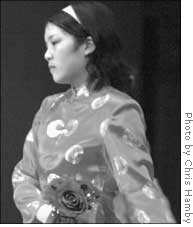
| << Front page | Arts | April 21, 2006 |
Performances Colored Beautifully
CoR Presents Many-Hued Performance
 |
||
| Ancient Tradition: A traditional Chinese dance. | ||
The tenth annual performance of Colors of Rhythm opened to a huge, rowdy crowd in Finney Chapel. According to its mission statement, “CoR...provide[s] a forum for and give[s] voice to disenfranchised artists and performers of color.”
Translated, Colors of Rhythm is actually a fun, highly politicized variety show with dances ranging from serious and polemic to sexy and hilarious.
The performances were extremely varied, and not all were by Oberlin students. Two groups came from the West Lake Chinese Cultural Association. The first group of girls, who looked to be about six or seven years old, were greeted with a chorus of “awwws.” They performed a traditional fan dance — a simple rotating line dance with fluffy pink fans and broad hand movements. The girls were terribly cute and also perfectly coordinated.
The WLCCA was not the only group to include tiny children. In the middle of “3 1/2” — an interesting, challenging dance by four men incorporating hip hop and reggae — three little girls, no older than four years old and called “the Sour Patch Kids” in the program, entered and began to imitate the sliding, jerky dance of the four. They may have gotten an even louder chorus of “awwws” than the fan dancers.
“3 1/2” itself was an impressive piece. Juniors Raymond Cummerlander and Jon Woods and sophomores Cassius Harris and Anthony Osei began slowly from simple movements while lying on their backs and accelerated to the point of a dance-off, involving one astonishing cartwheel and headstand. Some of the moves were at times a parody of athletic stretches, giving a subtle hint of the piece’s message about the role and perception of young black men in America.
A far more politically obvious performance was by the Students of Caribbean Ancestry. Their piece, “Effects and Possibilities of Resistance and Violence,” had three movements. The middle movement had the ten dancers enter, marching.
This eventually led to the male dancers throwing fake punches at each other in the best dance fighting since West Side Story, punctuated by bursts of an excessive gunfire sound effect. The performance was interesting but too overt to generate any discussion or call for interpretation.
The most striking and technically proficient performance of the evening was the tango, performed by senior Alexa Ramirez and Claudio Garcia. The masters of cermonies claimed that it was semi-improvised, but except for the occasional fumble or hesitation, that claim was difficult to believe. Bathed in red light, Garcia guided Ramirez into the most shocking dips and flips, eliciting gasps and spontaneous applause.
Other noteworthy performances were “Shik Shak Shouk,” an extremely well-choreographed pan-Arabian dance involving rustling metal skirts and a lit candle in each hand, and the Flamenco section of the three-part pan-Latin American dance “¡Somos Mestizos!” This last dance was not flamenco as it is typically portrayed — all red ruffles, grins and castanets — but a more slow, hazy, dreamlike dance.
The most original performance was probably “The Japan You Didn’t Know,” which incorporated geisha, a furry, school children, well-dressed ladies, sarariiman and other dancers representing nearly every one of the present wildly stratified Japanese fads.
The dancing itself was a bit uncoordinated, as were the musical changes, but
the piece was conceptually terrific and a great deal of fun. CoR should
certainly be commended for doing what it can to challenge stereotypes about
ethnic groups and ethnic art forms.
About us
Subscriptions
Advertising